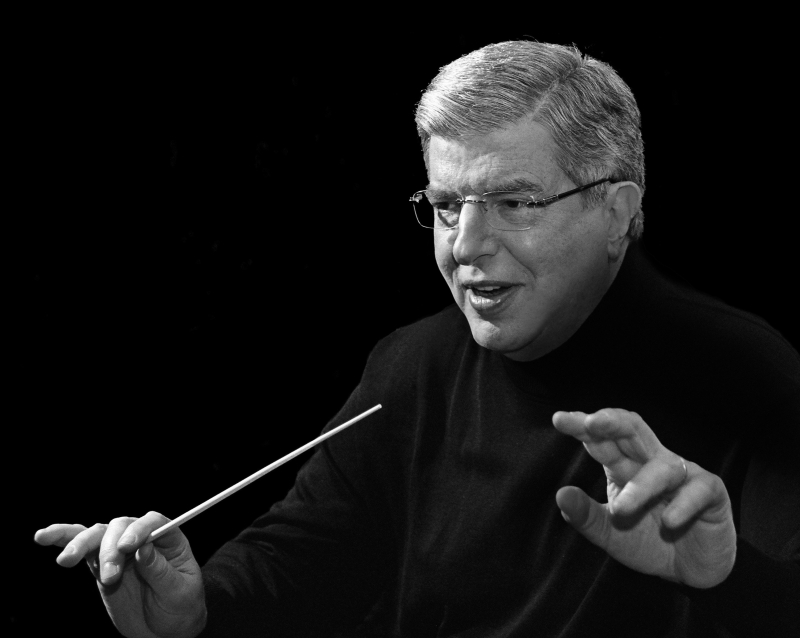Review: LOVE IS NEVER GONE Spotlights Marvin Hamlisch at Green Room 42
A reading of a bio-musical, filled with strongly sung songs
Melodies and memories of Marvin Hamlisch (1944-2012) have been included in solo and group cabaret shows over the years in venues that host such fare, but the presentation at The Green Room 42 on May 10th was not just a cabaret or concert with some comments. Oh, there were plenty of songs from this accomplished composer’s catalog, but this was a full-length bio-musical with dialogue scenes presenting key events and interactions as six performers played the roles of Hamlisch (Stearns Matthews, also narrating “in character”) and other real-life people. In songs used diegetically or repurposed as sung dialogue or the expression of a character’s thoughts, the audience heard strong singing voices in solos and the group numbers’ rich, ringing harmonies.
Marvin Hamlisch: Love Is Never Gone takes its subtitle from the lyric (and message) of “What I Did for Love” from his most successful musical, A Chorus Line. A very large amount of time was devoted to its landmark score, conversations with director/choreographer Michael Bennett (played by Jake Oswell), and related events, so that the proceedings — although entertainingly well done — started to feel like a not-so-mini-musical within a musical. Other scores were represented by only one song — or not musically sampled at all. Interestingly, there is another biographical musical, A Class Act, that covers the creation of A Chorus Line, focusing on its lyricist, Ed Kleban.
LOVE IS NEVER GONE, which had a different title in a presentation about a decade ago, was created and developed by James Horan, who, like me, is a longtime admirer of Hamlisch. As musical director, Mr. Horan was at the piano, very adroitly accompanying the cast, which included standout Corinna Sowers Adler — whose splendid voice and poise are a pleasure to behold — in the role of Terre, the woman Marvin married in 1989. The real Terre Blair Hamlisch was in the audience and came up after the bows to express her gratitude and approval, complimenting each member of the company individually. The  relationship with her husband, which began via many long telephone conversations over a long period before they met in person, leading to a blissful life together, was nicely handled. Although it’s been years since I read Marvin Hamlisch’s autobiography, The Way I Was (a source/ inspiration for this show), the facts and feelings surrounding their meeting and marriage stuck in my brain. However, it felt a little odd to have the Terre character singing words that had been written by Carole Bayer Sager, whose own romantic relationship with the composer in the 1970s was the inspiration for the musical they scored, with a script by Neil Simon, about partners in love and songwriting, They’re Playing Our Song. Carole Bayer Sager published her own memoir covering that time period and more with the same title. But you won’t see Carole as a character on stage, nor will you hear her name woven into the script of this saga about the life of a man who experienced fame, friendships, frustrations, failures, and fun as he composed, collaborated, conducted, and coped with carping critics. (Frank Stancati steps forward numerous times to deliver the published lines of reviewers mostly underwhelmed by various stage projects. Those stinging lines and the lack of lines at the box office, prompting short runs for some musicals, are shown to have discouraged the composer, despite his fame. However, some perspective is delivered when a colleague remarks pointedly that he’s traveled the world for years and never saw a statue of a reviewer.)
relationship with her husband, which began via many long telephone conversations over a long period before they met in person, leading to a blissful life together, was nicely handled. Although it’s been years since I read Marvin Hamlisch’s autobiography, The Way I Was (a source/ inspiration for this show), the facts and feelings surrounding their meeting and marriage stuck in my brain. However, it felt a little odd to have the Terre character singing words that had been written by Carole Bayer Sager, whose own romantic relationship with the composer in the 1970s was the inspiration for the musical they scored, with a script by Neil Simon, about partners in love and songwriting, They’re Playing Our Song. Carole Bayer Sager published her own memoir covering that time period and more with the same title. But you won’t see Carole as a character on stage, nor will you hear her name woven into the script of this saga about the life of a man who experienced fame, friendships, frustrations, failures, and fun as he composed, collaborated, conducted, and coped with carping critics. (Frank Stancati steps forward numerous times to deliver the published lines of reviewers mostly underwhelmed by various stage projects. Those stinging lines and the lack of lines at the box office, prompting short runs for some musicals, are shown to have discouraged the composer, despite his fame. However, some perspective is delivered when a colleague remarks pointedly that he’s traveled the world for years and never saw a statue of a reviewer.)
Stage and movie presentations of the lives of show business figures can be challenging to pull off, to put it mildly. Stearns Matthews was a likable Marvin, reflective and vulnerable in the narration, albeit calmer than the high-energy, fast-talking real guy. Elle Michaeli and Hannah Jane had the daunting tasks of playing, respectively, Liza Minnelli and Barbra Streisand. Each of these superstars has a uniquely distinctive singing style and sound, speech patterns, persona and personality. Some of the above was suggested, but these were not fully formed facsimiles or imperious impersonations.
Allowing some artistic license, the biography doesn’t get wildly fictionalized like some film and stage efforts in this genre that are a whirlwind of unconvincing cartoonish characterization, convenient coincidences, and clichés. However, if you didn’t already know the facts, you might think some career incidents sound made up: In the same month Marvin Hamlisch turned 20, Liza Minnelli records her first album and includes a song he co-wrote. He reluctantly takes a job playing piano at a party and is heard by a producer who offers him his first chance to score a major motion picture. “Fame can run to catch you or look right at you” is the apt lyric written by legendary Johnny Mercer for “Life Is What You Make It,” which wins them a Golden Globe Award in 1972. Two years later he gets another -- plus three Academy Awards, the year after he wins four Grammy Awards, and the year after that it’s the Tony Award and the Pulitzer Prize. Of course, every story of glory needs some tragedy: His beloved father dies the next year at age 70. Later, four different shows with his music come to Broadway, but each only lasts a few months and one produced in England has the same short lifespan and its planned American transfer is canceled. The storms are weathered with achievements in films, concerts, conducting and a happy marriage that might seem predicted in the aforementioned song written with Mercer, which also says “Somewhere out there, love waits to see you through.” (This encouraging piece is not included in the show.)
Marvin Hamlisch: Love Is Never Gone covers many years of life, love, and love songs, ranging from 1963’s mega-bouncy early pop confection “Sunshine, Lollipops and Rainbows,” to wistful recollections in “The Way We Were” and 1994’s serious melody with contemplative lyrics urging us all to make the world a better place by performing and appreciating “Ordinary Miracles.” It’s tough to predict the true potential of a theatre piece from a reading, without scenery or costume changes, with participants stepping up to stationary microphones attached to music stands holding scripts/sheet music. But the affection for the man and the songs is omnipresent: indeed, that "love is never gone."
Find more shows to see on Green Room 42's website.
Comments
.png)
|
.png)
|
Videos
